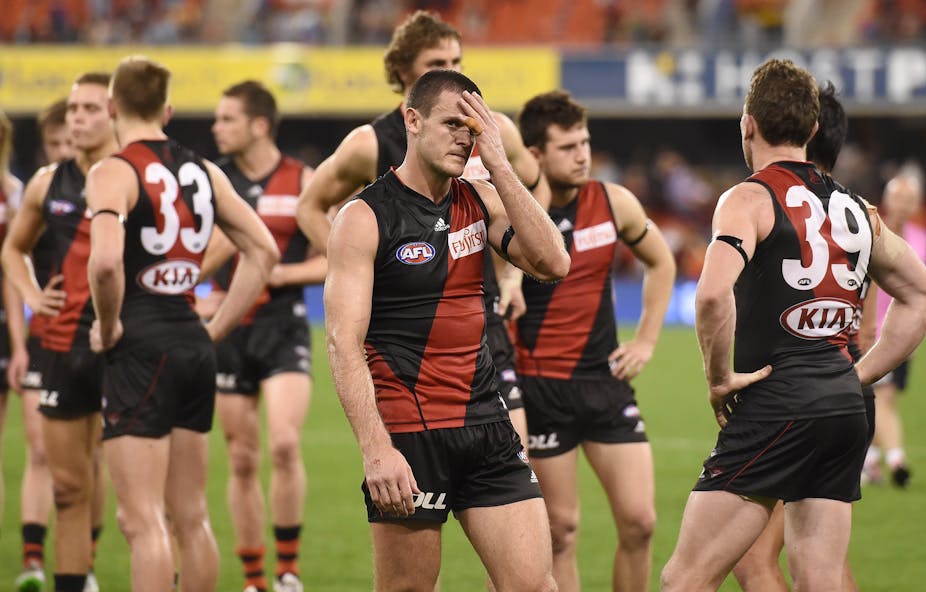This week the Court of Arbitration for Sport (CAS) meets in Sydney to hear a case by the World Anti-Doping Agency (WADA) against 34 past or present Essendon Football Club players. This hearing stems from WADA’s appeal against the finding of the AFL’s anti-doping tribunal that it was not “comfortably satisfied” that any of those players violated the sport’s WADA-approved anti-doping code.
In a separate case, the architect of the supplements regime at Essendon, Stephen Dank, has been found guilty of multiple violations of that code, and faces a “lifetime ban from all Australian sport”. WADA, although agreeing with that verdict, is concerned that some of the charges against Dank were dismissed, and so will appeal to CAS.
Meanwhile, Dank himself is appealing against the AFL anti-doping tribunal decision.
The two cases – one against players and the other against a sport scientist – are related as a matter of circumstance, though what is relevant by way of charges and evidence is distinctive to each case.
One substance – Thymosin Beta 4 (TB-4) – is at the heart of the case against the Essendon players. TB-4 occurs naturally in the body. One of its attributes is to help with “the repair and regeneration of damaged tissue”. However, supplementation of TB-4 is banned under the WADA Anti-Doping Code. Although it may have the potential to heal injured muscles, it is also presumed to enhance performance “artificially”.
WADA’s case against the Essendon players will be heard de novo, meaning that all of the previous evidence, as well as any new information, can be brought to CAS. Sports lawyer Darren Kane argues that the original case against the footballers “fell apart” because it relied inordinately on circumstantial evidence that a banned substance had been administered. There were no positive drug tests nor sworn testimonies to clinch a case of doping by players.
While it is difficult to predict what WADA will present to CAS, two lines of argument are likely to be at the fore. First, the prosecution will argue that the cumulative weight of circumstantial evidence is strong, whereas the defence will emphasise that the theory of a chain of events – from the purchase of TB-4, its importation to Australia, its distribution to Dank, and its administration to players – cannot be sustained.
In lay terms, CAS will be asked to rule whether such events “happened” and, just as importantly, whether they constitute links in a chain that led ultimately to 34 players being injected with TB-4.
There is no dispute that the footballers were injected, but the defence will argue that they were provided with a form of Thymosin (Thymomodulin) that is not banned by WADA.
At stake here is a question of legal interpretation. WADA will assert that under the CAS standard of “comfortable satisfaction”, the circumstantial evidence is sufficient for a guilty verdict. The defence will pick holes in the links said to underpin a causal chain, thereby casting doubt about the adequacy of the prosecution’s overall case.
Second, WADA claims that it has new evidence to bolster its circumstantial case. When the case against the Essendon players was heard by the AFL tribunal in early 2015, the prosecution did not draw upon biological samples from these athletes. However, in August this year WADA reported that it had recently sent frozen urine samples to the world’s leading anti-doping laboratory – in Cologne, Germany – and found “abnormally high amounts of thymosin beta 4” in two of the 27 Essendon players tested between between December 2011 and August 2012.
There are at least a couple of ways of looking at this:
two players with elevated TB-4 is evidence that a doping program had taken place; or
if only two players had elevated TB-4, how is this evidence of a club-wide, systematic doping program?
The other point that the defence will keep in mind is uncertainty about how to “read” TB-4 levels, given that it is a naturally occurring substance in the body. Both sides will call scientists to provide opinions about this. From the players’ perspective, Monash University’s Richard Boyd has asserted:
If you are trying to define whether these players have got elevated levels … you need to have a very good handle on what the levels are in normal people in different stages of life and different stages of physiology. Things can change from the morning to the night, with tiredness, with exercise. It is a complex system.
Boyd might have added that variations of biological markers are, in fact, integral to WADA’s innovative Athlete Biological Passport system, which was implemented in 2009. Under this program, when athletes are tested – whether by blood or urine – the sample is not simply analysed for banned substances, it is also recorded as information about an individual’s “biological profile”.
The assumption is that if, over time, there are variations in certain biological markers, then anti-doping authorities will seek to target test those under “suspicion” with the aim of either proving or discounting doping.
It is unclear whether WADA has cumulative information about the biological passport status of the Essendon players in the 2011-12 period. Even so, that data hardly amounts to evidence of doping. There is no suggestion that Essendon footballers have since tested positive to TB-4.
Richard Ings, the ex-CEO of ASADA, famously described February 7 as “the blackest day in Australian sport”. This was the occasion when the federal government, several of the nation’s leading sports, together with ASADA and the Australian Crime Commission, came to grips with allegations of suspected doping and use of illicit drugs in sport. Essendon, alongside the NRL’s Cronulla, became the focus of ASADA’s attention.
The Cronulla players accepted what Ings described as “a sweetheart deal” – a three-week ban in the pre-season. The Essendon footballers refused to bargain, instead committing to a long-haul defence of their reputations. Whether the wait was “worth it” will depend, in large part, on the CAS verdict in Sydney.

